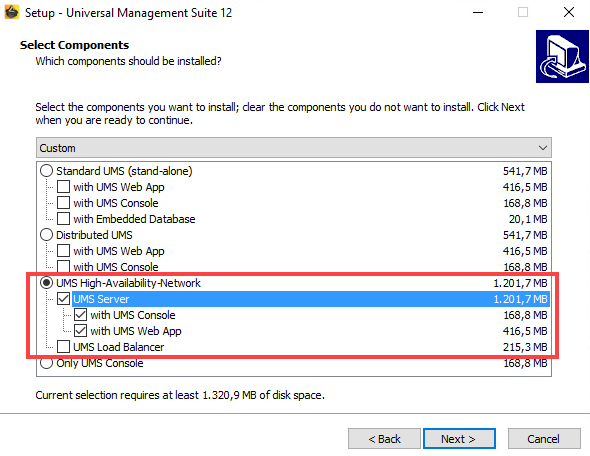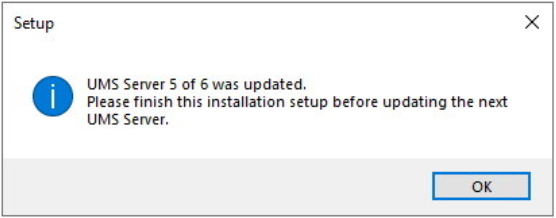How to Update a UMS HA Installation: Without Downtime of the Servers
Before the update, see Updating the Installation of an HA Network.
To update the HA installation, follow these instructions in the order given.
Preparing the Update
Perform the following steps before updating a server:
Download the current version of IGEL Universal Management Suite from the IGEL Download Server and distribute the installer file to all systems with UMS components (UMS Server, UMS Load Balancer, UMS Consoles).
In the UMS Console, call up the list of UMS Servers and Load Balancers in the HA network under UMS Administration > UMS Network and check whether the listed components really exist in the network. Delete orphaned entries before starting the process for updating the components.

Create a backup of your database before starting the update installation. Use the backup procedures recommended by the DBMS manufacturer. See also Creating a Backup of the IGEL UMS.
Warning
It is not possible to install a UMS version which is older than the current one. If you want to change to an older version (e.g. from 6.10 to 6.09), you will need to install a separate HA network and restore a database backup of the corresponding schema. This is also one of the reasons why you should back up the running system before updating the UMS HA network.
Since the version of the database schema always corresponds to the current major.minor version of the UMS (i.e. 6.10 for all 6.10.x releases, 6.08 for all 6.08.x. releases), the downgrades are only possible within a major.minor version. Example: you can downgrade from 6.10.140 to 6.10.120, but not from 6.10.140 to 6.09.120.
Verify that the time on all servers is synchronized.
To avoid problems with your HA installation, make sure that the time on the servers of the HA network does not differ by more than one minute. After each manual time reset, the HA services on the relevant server must be restarted.
Updating UMS Servers
In the update mode, the UMS Servers run with a local copy of the database. This ensures that they can answer requests from the devices and transfer configuration settings and profiles to the devices.
In the update mode, you can connect to the servers via the UMS Console. All changes made in the UMS Console during this time will be lost after the update.
Warning
Do not make changes in the productive database during the update process. This is because decoupled servers work with a copy of the database schema in the meantime. For this reason, the update of all components within the UMS HA network should be carried out immediately. Implement a test system for the first installation of new IGEL UMS versions and check their processes before transferring them to the productive system. This also applies to hotfixes, patches, etc. for server systems and databases.
Updating the First UMS Servers
You can select any UMS Server within the HA network to start the update procedure.
Launch the UMS installer.
You need administration rights to update the IGEL UMS HA.When installing the UMS Server as a part of the HA network on Linux, the directory
/rootmust be writable for the userroot.Read and confirm the License Agreement.
Read the Information regarding the installation process.
Verify the components to be installed. (In this case: HA network with UMS Server and UMS Load Balancer installed individually)

Confirm the system requirements dialog if your system fulfills them.
Under Select Additional Tasks, specify whether you would like to create shortcuts for the UMS Console and UMS Administrator on the desktop.
If the internal Windows firewall is active on your host: Review the settings under Windows firewall settings and change them where necessary. Each port that is activated here will be set as rule in the Windows firewall.
UMS 12 Communication Ports
If you are going to make network changes, consider the following ports and paths:
For IGEL OS 12 devices, TCP 8443
/device-connector/*is required.
SSL can be terminated at the reverse proxy / external load balancer (see IGEL Universal Management Suite Network Configuration ) or at the UMS Server.For importing IGEL OS 12 Apps to the UMS from the IGEL App Portal, the URL https://app.igel.com/ (TCP 443) is required.
For the UMS Web App, TCP 8443
/webapp/*and/wums-app/*are required.For the UMS Console, the root is required, i.e. TCP 8443
/*For IGEL OS 11 devices, TCP 30001 and TCP/UDP 30005 are required.
For more information on UMS ports, see IGEL UMS Communication Ports .
Read the summary and start the installation process.
During the installation, the UMS Server switches to update mode.Confirm the message
n of m servers updated.
Example:
Close the UMS installer once the installation is complete.
If SQL Server AD Native is used, you must also set the correct startup type and logon settings for the "IGEL RMGUIServer" service and restart the service. This must be done on ALL UMS Server hosts. For more information, see Microsoft SQL Server/Cluster with Native Active Directory (AD) Authentication .
Continue with the update of the next UMS Server.
Updating the Last UMS Server
→ Repeat steps 1-9 on the last UMS Server to be updated.
The last UMS Server updated renews the schema of the productive database after the installation. All other UMS Servers within the network which run in the update mode will be informed that the installation has finished. They will restart and reconnect themselves to the productive database. Afterwards, they will run in normal mode.
Updating Further Components
After updating the UMS Servers within the HA network, you have to update all other current UMS components, e.g. separate UMS Load Balancers and UMS Consoles.
In order to do this, run the UMS installer on the systems.
Verify the components to be installed.
You cannot connect to the UMS Server with a console version that is older than the version of the UMS Server.Load balancers are able to interoperate with UMS Servers of newer versions, but they should have the same version as the UMS Servers for optimal performance.
See also Troubleshooting: Load Balancer Is Not Stopping during the Update of the HA Installation.
Checking the Installation
Check if all processes are running. For the list of UMS HA processes, see IGEL UMS HA Services and Processes.
In the UMS Administrator, go to Datasource to check if the database is activated.
If the server list has not been checked at the beginning of the update (see Preparing the Update, step 2) and there have been more servers registered in the database than actually running, it might be the case that there is a server within the HA network that did not reconnect to the productive database.
In this case, you have to switch over the data source manually to the productive database or you can use for this purpose the button End update mode for local UMS Server in the UMS Administrator > Distributed UMS.
The database schema will be renewed the first time an updated server connects to the productive database. Afterwards, all other servers within the network can be switched over to this database.
In the UMS Console, go to UMS Administration > UMS Network and check the items Server and Load Balancer.
All servers and load balancers must be:updated
running
in normal mode

